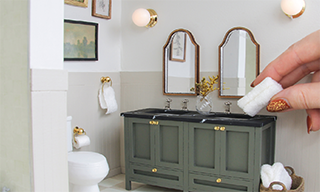Make 1/12-Scale Wood Blinds From Houseworks® Flooring
By Fran Casselman

The blinds are installed in #50610 15-Light Non-Working Window.
Materials & Tools:
#7022 Red Oak Flooring
1/4" x 1/4" strip wood #17522 for header rail
1/8" x 1/4" strip wood #17511 for bottom rail (optional) Note: you could also glue together two strips of the flooring, paper-to-paper, for this optional add-on
#97008 Ultimate Craft Knife
#41134 Ultimate Easy Cutter
#60935 Finger Drills
Clear seed beads
Monofilament (fishing line)
Masking tape or frosted clear tape
#10115 12" Stainless Steel Ruler
Pencil

Houseworks #7022 Red Oak Wood Flooring is in 1/4" “boards," which are just the right width for slats of a wood window blind. Because the boards are exactly parallel and securely mounted to a stable paper base, it’s easy to get perfectly aligned holes for stringing the slats together. You may already have flooring left from a previous project; this is the perfect way to use it.
It is easiest to stain or otherwise finish the flooring and header/bottom rails first. I have had very good results with Kiwi Color Shine liquid shoe polish (in brown, for this project). It goes on easily, dries well, does not permanently distort the flooring or cause it to separate from the backing paper, and can be buffed to a soft sheen after light sanding. Whatever method you use, be sure the flooring is completely dry before proceeding.
Measure the width of the window* where the blind will go; allow a little clearance. (For a standard Houseworks window such as #5023, this is about 2 3/16".) Cut a piece of flooring to this width. You will need about 12 slats per inch of finished blind, so the amount of flooring needed depends on how much coverage you want. I did not notice a problem using slats where the flooring has a joint, but allow for extra slats to use in place of jointed ones if it bothers you.
Cut the bottom rail the same width; cut the header rail to a snug fit inside the top of the window.

On the paper side of the flooring, mark a line 1/2" in from each end of the strip width and the full length of the flooring piece(s). Fold the flooring between each strip and crease the paper; add a pencil mark in the creases to define the strips. Drill a tiny hole in the center of each strip’s width along the 1/2" line. Drill matching holes in the header and bottom rail. Separate the strips by cutting the paper at the creases.
Cut a length of monofilament longer than you will need. Fold it in half to find the center, and tape it to the center bottom of the bottom rail (for temporary stability, or trim tape and leave in place). Feed an end of the monofilament through each of the holes, then a seed bead on each side followed by the first strip. Continue adding beads and strips until complete, then add the header.
Knot the monofilament ends together, cut off excess and mount the shade with your choice of permanent or temporary adhesive. As an alternate mounting method, drill holes up through the top of the window frame and feed the monofilament through, then knot or tape down the ends so the shade is secure but still removable.
*The window in the photos is #50610 15-Light Non-Working Window (with a modified pediment), so the measurements are different: the flooring strips are 4 1/2" wide; the line for holes is 7/8" in from each end.



